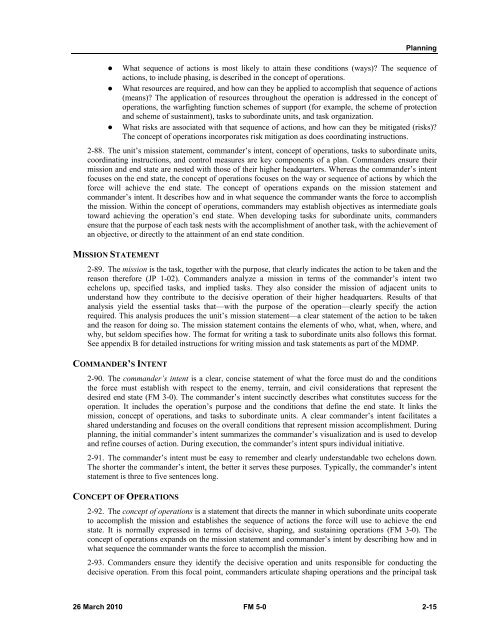FM 5-0, The Operations Process - Federation of American Scientists
FM 5-0, The Operations Process - Federation of American Scientists
FM 5-0, The Operations Process - Federation of American Scientists
Create successful ePaper yourself
Turn your PDF publications into a flip-book with our unique Google optimized e-Paper software.
Planning<br />
• What sequence <strong>of</strong> actions is most likely to attain these conditions (ways)? <strong>The</strong> sequence <strong>of</strong><br />
actions, to include phasing, is described in the concept <strong>of</strong> operations.<br />
• What resources are required, and how can they be applied to accomplish that sequence <strong>of</strong> actions<br />
(means)? <strong>The</strong> application <strong>of</strong> resources throughout the operation is addressed in the concept <strong>of</strong><br />
operations, the warfighting function schemes <strong>of</strong> support (for example, the scheme <strong>of</strong> protection<br />
and scheme <strong>of</strong> sustainment), tasks to subordinate units, and task organization.<br />
• What risks are associated with that sequence <strong>of</strong> actions, and how can they be mitigated (risks)?<br />
<strong>The</strong> concept <strong>of</strong> operations incorporates risk mitigation as does coordinating instructions.<br />
2-88. <strong>The</strong> unit’s mission statement, commander’s intent, concept <strong>of</strong> operations, tasks to subordinate units,<br />
coordinating instructions, and control measures are key components <strong>of</strong> a plan. Commanders ensure their<br />
mission and end state are nested with those <strong>of</strong> their higher headquarters. Whereas the commander’s intent<br />
focuses on the end state, the concept <strong>of</strong> operations focuses on the way or sequence <strong>of</strong> actions by which the<br />
force will achieve the end state. <strong>The</strong> concept <strong>of</strong> operations expands on the mission statement and<br />
commander’s intent. It describes how and in what sequence the commander wants the force to accomplish<br />
the mission. Within the concept <strong>of</strong> operations, commanders may establish objectives as intermediate goals<br />
toward achieving the operation’s end state. When developing tasks for subordinate units, commanders<br />
ensure that the purpose <strong>of</strong> each task nests with the accomplishment <strong>of</strong> another task, with the achievement <strong>of</strong><br />
an objective, or directly to the attainment <strong>of</strong> an end state condition.<br />
MISSION STATEMENT<br />
2-89. <strong>The</strong> mission is the task, together with the purpose, that clearly indicates the action to be taken and the<br />
reason therefore (JP 1-02). Commanders analyze a mission in terms <strong>of</strong> the commander’s intent two<br />
echelons up, specified tasks, and implied tasks. <strong>The</strong>y also consider the mission <strong>of</strong> adjacent units to<br />
understand how they contribute to the decisive operation <strong>of</strong> their higher headquarters. Results <strong>of</strong> that<br />
analysis yield the essential tasks that—with the purpose <strong>of</strong> the operation—clearly specify the action<br />
required. This analysis produces the unit’s mission statement—a clear statement <strong>of</strong> the action to be taken<br />
and the reason for doing so. <strong>The</strong> mission statement contains the elements <strong>of</strong> who, what, when, where, and<br />
why, but seldom specifies how. <strong>The</strong> format for writing a task to subordinate units also follows this format.<br />
See appendix B for detailed instructions for writing mission and task statements as part <strong>of</strong> the MDMP.<br />
COMMANDER’S INTENT<br />
2-90. <strong>The</strong> commander’s intent is a clear, concise statement <strong>of</strong> what the force must do and the conditions<br />
the force must establish with respect to the enemy, terrain, and civil considerations that represent the<br />
desired end state (<strong>FM</strong> 3-0). <strong>The</strong> commander’s intent succinctly describes what constitutes success for the<br />
operation. It includes the operation’s purpose and the conditions that define the end state. It links the<br />
mission, concept <strong>of</strong> operations, and tasks to subordinate units. A clear commander’s intent facilitates a<br />
shared understanding and focuses on the overall conditions that represent mission accomplishment. During<br />
planning, the initial commander’s intent summarizes the commander’s visualization and is used to develop<br />
and refine courses <strong>of</strong> action. During execution, the commander’s intent spurs individual initiative.<br />
2-91. <strong>The</strong> commander’s intent must be easy to remember and clearly understandable two echelons down.<br />
<strong>The</strong> shorter the commander’s intent, the better it serves these purposes. Typically, the commander’s intent<br />
statement is three to five sentences long.<br />
CONCEPT OF OPERATIONS<br />
2-92. <strong>The</strong> concept <strong>of</strong> operations is a statement that directs the manner in which subordinate units cooperate<br />
to accomplish the mission and establishes the sequence <strong>of</strong> actions the force will use to achieve the end<br />
state. It is normally expressed in terms <strong>of</strong> decisive, shaping, and sustaining operations (<strong>FM</strong> 3-0). <strong>The</strong><br />
concept <strong>of</strong> operations expands on the mission statement and commander’s intent by describing how and in<br />
what sequence the commander wants the force to accomplish the mission.<br />
2-93. Commanders ensure they identify the decisive operation and units responsible for conducting the<br />
decisive operation. From this focal point, commanders articulate shaping operations and the principal task<br />
26 March 2010 <strong>FM</strong> 5-0 2-15















